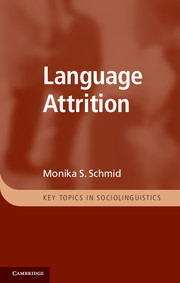Book contents
- Frontmatter
- Contents
- List of figures
- List of tables
- Preface
- Abbreviations
- 1 Introduction
- Part I Linguistic aspects of language attrition
- Part II Extralinguistic aspects of language attrition
- Part III Conducting research on language attrition – preliminary considerations
- Part IV Experimental designs for attrition research – the language attrition test battery
- Part V Coding and analysing the data
- 15 Transcribing and coding free speech: the CHILDES project
- 16 Coding and reporting experimental data
- 17 Interpreting your data: inferential statistics
- 18 Conclusion
- Glossary
- Notes
- References
- Index
16 - Coding and reporting experimental data
Published online by Cambridge University Press: 05 June 2012
- Frontmatter
- Contents
- List of figures
- List of tables
- Preface
- Abbreviations
- 1 Introduction
- Part I Linguistic aspects of language attrition
- Part II Extralinguistic aspects of language attrition
- Part III Conducting research on language attrition – preliminary considerations
- Part IV Experimental designs for attrition research – the language attrition test battery
- Part V Coding and analysing the data
- 15 Transcribing and coding free speech: the CHILDES project
- 16 Coding and reporting experimental data
- 17 Interpreting your data: inferential statistics
- 18 Conclusion
- Glossary
- Notes
- References
- Index
Summary
The results from experimental data come in various forms – reaction times, accuracy scores, judgments on a five-point scale, yes/no answers, and so on. This chapter will discuss how such different types of data can be coded, what information you need to give when you describe them, and how you may present this information in tables and graphs.
The transcription and tagging of free speech, as discussed in the previous section, is by far the most difficult and time-consuming way of coding linguistic data. Data elicited by controlled experiments or tests, on the other hand, can usually be coded relatively quickly once you have set up your database. During my own fieldwork I was usually able to enter all of the data (the sociolinguistic questionnaire, two Verbal Fluency Tasks, five C-Tests in each language, two Wug-tests and two Can-Do Scales) into my database while the next participant was completing the written tasks.
Before you start setting up this database, however, there are some important considerations and decisions to make. These mainly concern the following issues:
Types of data
Missing data
How to report and visualize your results
TYPES OF DATA
The first thing that you will be taught in any statistics course is that numbers are not always numbers: the mathematical and statistical operations you are allowed to perform crucially depend on how the numbers within the scale that you are applying relate to each other.
Information
- Type
- Chapter
- Information
- Language Attrition , pp. 208 - 224Publisher: Cambridge University PressPrint publication year: 2011
